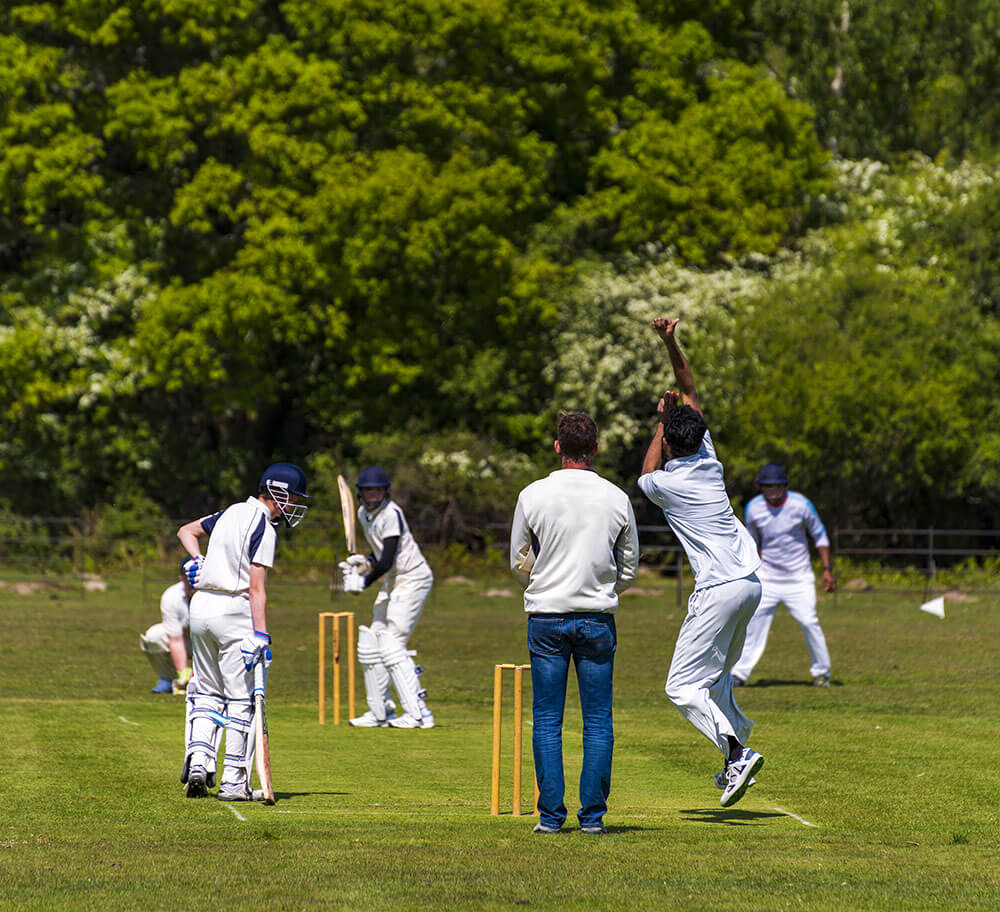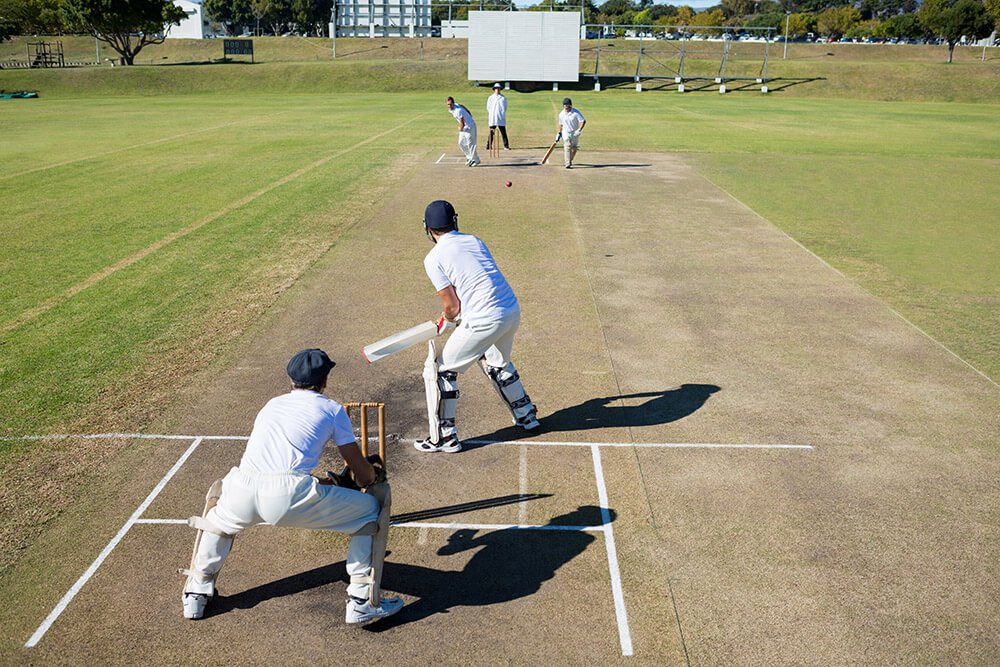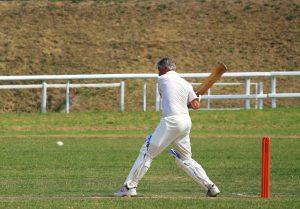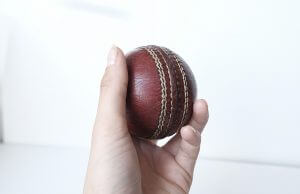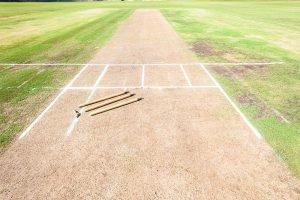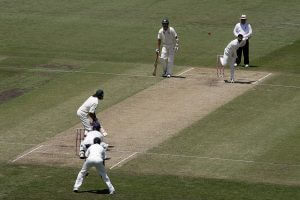Best Cricket Batting Tips
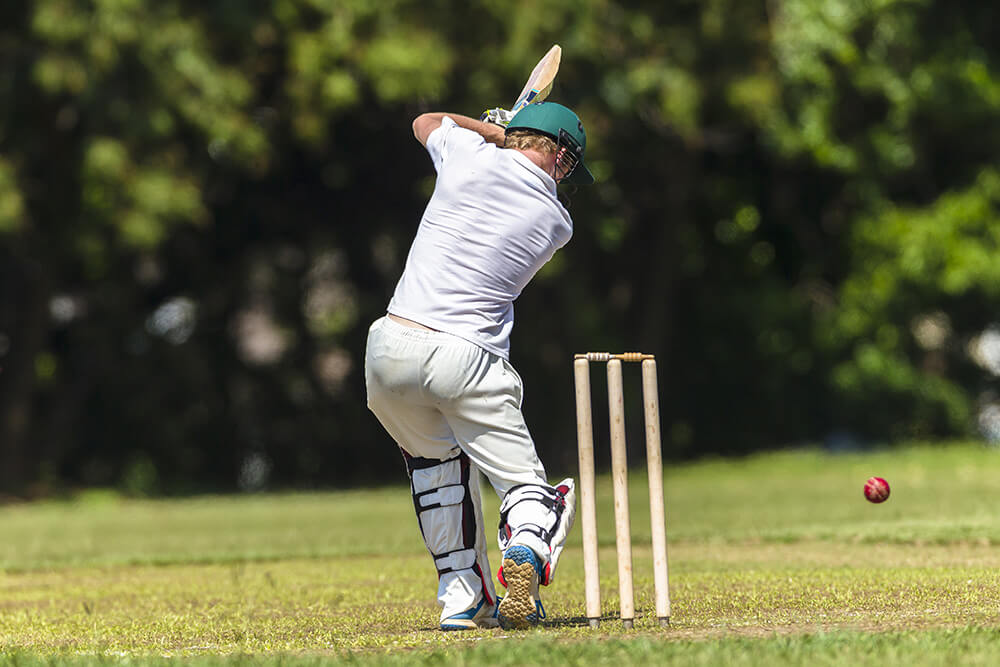
These batting tips are intended for those who already play the game, not for those who are learning how to play. Therefore, we will not focus on choosing the right bat to play with, give advice on how to grip the bat, how to take a guard at the wicket or how to run between the wickets. Instead, we will tell you how to optimise your current skills to become better at what you already do.
You may have heard many of these tips in the past but probably not all of them in one place. Through this article, we hope to provide you with a useful template in your quest to optimising your batting performance in a match.
Contents
Watch the Ball
This is the first thing you must learn to do if you wish to become a successful batsman. You must watch the ball as the bowler holds it in his hand and approaches the crease before delivering the ball. You must keep your head perfectly still. You can tap the bat rhythmically as it will help you concentrate. Watch the ball through the whole bowling motion, beginning with the approach, the gather and the release. This way, you are looking for clues that will help predict where the ball is likely to land and what shot you can play.
Learn to Predict the Delivery
You are looking to play every ball on its merit. You cannot expect a bowler to bowl six brilliant deliveries in an over. So being watchful will help you recognise a bad ball when it comes your way. Have in mind, one mistake is all you can make as a batsman. There is no comeback after you have made that mistake: the only way to go is back to the pavilion. Watching the ball must become second nature to you as a batsman. Then you will discover that you are able to predict with a degree of accuracy as to the quality of the delivery you are likely to get. Once you know what kind of ball is on its way, you know what to do to counter it. You can adjust your footwork and shot accordingly.
Look to Score
Eventually, cricket is a mental game, with bowler and batsman looking for ways to upstage one another. So positive intent is key to your success. A defensive mindset will allow the bowler to gain ascendancy. Hence the best approach is to look to score off every ball. If you choose to defend the ball, you should make that decision based on the merit of the ball. The position of your head is an indication of your intent. The head should be tilted slightly forward. When you keep your head still, your control on the shot will improve. So will your choice of shot.
Steer with the Front Shoulder
Where you decide to hit the ball will be indicated by the way you move your front shoulder which will help steer the ball in the direction you choose. For instance, an open shoulder will facilitate a shot into the leg side while a closed shoulder will be better suited to an offside stroke. When you play a stroke of the front foot, the front shoulder will take charge.
Footwork Matters
Footwork is crucial to enabling you to strike the ball effectively. If you try to hit the ball without moving your feet, you could get found out. You would need to get in line with the ball before executing a shot. If you are watching the ball and know what you can expect to receive, your feet will move accordingly. Especially against spin bowling, your ability to move your feet will be tested. The use of your feet is preceded by judging the most optimal angle and space you would need to execute a shot. You will get confirmation of the proper use of your feet when the ball meets the centre of your bat.
Know Where the Fielders Are
Before you hunker down to receiving the ball, look around the field. Rather than looking at fielders, understand where the gaps in the field are. As your primary intent is to score runs, it is important for you to know the areas in which you can get the runs.
See Past a Trap
For instance, you may be aiming to play a pull shot after seeing the line the bowler is bowling. However, a glance may show you that the fielding captain has placed a fielder in the deep for a possible catch. Thus, you can change your strategy accordingly. Moreover, at times, fielding captains may mistakenly place more than two fielders behind square on the legside. As you are probably aware, that would qualify for the ball to be called a no-ball. You can take advantage of it as you cannot be dismissed in ordinary ways off a no-ball.
Field placements can also give the batsman a clue about the fielding side’s strategy as well as the bowler’s intent. Sometimes, the fielding side will invite a single when they want the non-striker to face the bowling. A batsman who recognises the signs can decide whether he wants a run. This often happens when a regular batsman is batting with a tail-ender and the fielding side wants a wicket.
Avoid Run Outs
Often run outs result because the batsman is not aware of where the fielders are placed. This is especially so when the batsman calls the runner for a quick single. Often mix ups take place when the runner can see the fielder though the striker does not. In such cases, the runner may refuse to budge, leaving the striker stranded down the wicket.
Play Each Ball One at a Time
As a batsman, you are looking to playing a long innings. A long journey can become less cumbersome if you can break it up into smaller segments. You can view each ball in an innings as a segment. When you take care of the part, the whole takes care of itself. This is especially true of a cricket innings. The most successful batsmen are the ones who play every ball on its merit.
Manage Your Innings
Beyond a delivery, you can think of how to manage an over. Beyond an over, you can think of managing a session of play. But the smallest unit you would need to manage as a batsman is an individual ball in an over. Once you have survived a ball, you are ready to receive the next one. A batsman has only one life. One mistake is all he can make before being sent on his way. The fact that you are still at the wicket after a ball has been bowled should encourage you to negotiate the next ball with the same amount of success. When you manage one ball at a time, before long you realise that you have played several overs and you have the runs to show for it. Don’t think about how many runs you are likely to score; rather, focus on dealing successfully with the next ball that you are about to receive. Soon, you will find that it has become a habit and building an innings is easier than you have thought.
Play Each Ball One at a Time
As a batsman, you are looking to playing a long innings. A long journey can become less cumbersome if you can break it up into smaller segments. You can view each ball in an innings as a segment. When you take care of the part, the whole takes care of itself. This is especially true of a cricket innings. The most successful batsmen are the ones who play every ball on its merit.Manage Your Innings
Beyond a delivery, you can think of how to manage an over. Beyond an over, you can think of managing a session of play. But the smallest unit you would need to manage as a batsman is an individual ball in an over. Once you have survived a ball, you are ready to receive the next one. A batsman has only one life. One mistake is all he can make before being sent on his way. The fact that you are still at the wicket after a ball has been bowled should encourage you to negotiate the next ball with the same amount of success. When you manage one ball at a time, before long you realise that you have played several overs and you have the runs to show for it. Don’t think about how many runs you are likely to score; rather, focus on dealing successfully with the next ball that you are about to receive. Soon, you will find that it has become a habit and building an innings is easier than you have thought.
RoRotate the strike
tating the strike is a very important part of batsmanship. As it has been already stated, the batsman at the crease must look to score runs off every ball he receives. Merely staying at the crease, while not scoring any runs, will not serve your team’s cause. You have been sent to make runs and give your bowlers something to bowl against. That’s your job. However, sometimes, a batsman may get bogged down for one of several reasons. It’s possible that a bowler is bowling exceptionally well and the batsman’s primary aim is not to lose his wicket. This could happen to the best of batsmen. In a recent Test match between Australia and New Zealand at the Sydney Cricket Ground in Sydney, Australia, Steve Smith who is one of the world’s best batsmen needed 38 balls before he could get off the mark.
Pressurise tPressurise the Fielding Side
ting the strike can also put pressure on the fielding side. The bowler may be cooking up a strategy to get a batsman out. However, with a constant rotation of the strike, the bowler may need to rethink his strategy. It will be doubly more uncomfortable for the bowler as well as fielders if a right-hander and left-hander are together at the wicket. With a new batsman on strike every ball or two, the bowler will not be able to settle into a rhythm. Also, fielders’ positions will need to be changed often as the fielding team adjusts to a different-handed batsman at the striker’s end. Rotating the strike becomes easier when you know where the fielders are placed, allowing you, the striker, to call for a quick single after hitting the ball into a rotation area. Rotation of the strike can also help you get off-strike when you are facing a bowler you are not comfortable against. And if the other batsman is playing well, he can tire the bowler out and blunt his edge.
Know What You ArKnow What You Are Good At
field, knowing your strengths and weaknesses can boost your success in cricket, provided you choose to play to your strengths. For instance, if you tend to play on the front foot more often, look to exploit your strength. Unless the bowler changes tack and starts bowling shorter, you can look to playing forward. If you prefer to play on the back foot, then stick with your style. Don’t forget to always take care to judge the merit of the ball before you decide to play a shot. There is no point getting into a tangle because you have decided to play forward to a short-pitched delivery or stayed back to a pitched-up ball.
Be Versatile
Be Versatile
aiming at becoming a versatile player, you must hone your ability to adjust to the nature of bowling while seeking to play to your strengths. Don’t expect the bowler to pander to your strengths. At the same time, be alert to every possibility of making runs by using your favourite shots. By being prepared to adjust your shot-making in accordance with the bowler’s strategy, you can expand your range of shots, even when relying on your favourite strokes. Essentially, it requires you to form a batting strategy to overcome anything the bowler can conjure. If, for instance, the field placement and bowling areas prevent you from getting runs by your favourite cover drives and pulls, you must be just as willing to bide your time while resorting to garnering runs with flicks and drives on the legside.
Learn How to Regain FoLearn How to Regain Form
n the world can go through a bad patch. Form can desert you when you least expect it. One day, you are on top of the world with the seeming ability to play any type of bowling to any part of the ground. The next day, you cannot get to middle the ball at all. It’s very easy to get frustrated when you lose form but losing your temper will do nothing to help regain your form.
Learn the Cause
Pressurise the Fielding Side
ting the strike can also put pressure on the fielding side. The bowler may be cooking up a strategy to get a batsman out. However, with a constant rotation of the strike, the bowler may need to rethink his strategy. It will be doubly more uncomfortable for the bowler as well as fielders if a right-hander and left-hander are together at the wicket. With a new batsman on strike every ball or two, the bowler will not be able to settle into a rhythm. Also, fielders’ positions will need to be changed often as the fielding team adjusts to a different-handed batsman at the striker’s end. Rotating the strike becomes easier when you know where the fielders are placed, allowing you, the striker, to call for a quick single after hitting the ball into a rotation area. Rotation of the strike can also help you get off-strike when you are facing a bowler you are not comfortable against. And if the other batsman is playing well, he can tire the bowler out and blunt his edge.Know What You ArKnow What You Are Good At
field, knowing your strengths and weaknesses can boost your success in cricket, provided you choose to play to your strengths. For instance, if you tend to play on the front foot more often, look to exploit your strength. Unless the bowler changes tack and starts bowling shorter, you can look to playing forward. If you prefer to play on the back foot, then stick with your style. Don’t forget to always take care to judge the merit of the ball before you decide to play a shot. There is no point getting into a tangle because you have decided to play forward to a short-pitched delivery or stayed back to a pitched-up ball.
Be Versatile
Be Versatile
aiming at becoming a versatile player, you must hone your ability to adjust to the nature of bowling while seeking to play to your strengths. Don’t expect the bowler to pander to your strengths. At the same time, be alert to every possibility of making runs by using your favourite shots. By being prepared to adjust your shot-making in accordance with the bowler’s strategy, you can expand your range of shots, even when relying on your favourite strokes. Essentially, it requires you to form a batting strategy to overcome anything the bowler can conjure. If, for instance, the field placement and bowling areas prevent you from getting runs by your favourite cover drives and pulls, you must be just as willing to bide your time while resorting to garnering runs with flicks and drives on the legside.
Learn How to Regain FoLearn How to Regain Form
n the world can go through a bad patch. Form can desert you when you least expect it. One day, you are on top of the world with the seeming ability to play any type of bowling to any part of the ground. The next day, you cannot get to middle the ball at all. It’s very easy to get frustrated when you lose form but losing your temper will do nothing to help regain your form.
Learn the Cause
Learn How to Regain Form
n the world can go through a bad patch. Form can desert you when you least expect it. One day, you are on top of the world with the seeming ability to play any type of bowling to any part of the ground. The next day, you cannot get to middle the ball at all. It’s very easy to get frustrated when you lose form but losing your temper will do nothing to help regain your form.Learn the Cause
Learn the Cause
e of your loss of form can help regain it. Some of the most important reasons for a loss of form include lack of practice. When you have not played for some time and are returning to the game after a hiatus, you could find yourself a bit rusty. This is perfectly natural and it is important for you to recognise that errors can creep in when you don’t practise regularly. Another reason could be injuries or aches and pains arising from a lack of optimal fitness. Sometimes, a player may train too hard. Too much of a good thing can be bad, because when novelty is lost and playing becomes a boring routine, you are no longer motivated to do your best. Sometimes, personal problems can result in poor form on the field – it could be something to do with your relationships, financial or work-related issues. Overconfidence can often spell doom as it can make you imagine you are better than you are. Sometimes, a single bad performance may trigger a loss of confidence and, as a result, a longer-lasting loss of form. It all boils down to motivation: do you really want to do well?Return to Basics
Return to Basics
ackle loss of form is to return to basics. Go to the nets. Spend longer hours practising. Get a bowler to bowl in your favourite areas, so that you can play your favourite stroke. You know when you are in good form when you are striking the ball well. So, it is important to keep playing your best shots so that you can trigger a memory of the last time you were in good form. It can also help to write down what you plan to do as that will increase your intent as to your game plan and help to remind you about your strategy and how you intend to structure your innings.Don’t Focus Too MuchDon’t Focus Too Much on Technique
ll when you keep it simple and natural. Your technique is operating in the back of your mind ensuring that you do the right things and avoid the wrong ones. You must spend your time at the crease scoring runs, not analysing your technique. If you wish to address your technique the best place is at the nets. Then again, you must not delve into it too deeply. Have a simple list of checkpoints based on your knowledge of your strengths and weaknesses. Adhere to the list only to the extent that it makes you feel comfortable at the crease. Leave the in-depth analysis to coaches and let them tell you in simple language what you can do to improve. Focus on scoring runs and be happy if you succeed.
Be Balanced in Your StanceBe Balanced in Your Stance
is crucial to your comfort at the batting crease. It can give you the peace of mind you need to focus on scoring runs. Spread your feet evenly apart and line up your toes with the middle stump. Don’t feel awkward about being different from other batsmen. You must do what makes you comfortable, even if that means spreading your feet a greater distance apart. The balance of weight must rest on the inside of your feet to allow you to move forward or back more easily. As we saw earlier in this article, you must stand with your head inclined forward, while pointing your shoulder towards the bowler. Keep your eyes level while making sure that you grip your bat with the guiding hand while keeping the other one relaxed. If you are a right-hander, your top (guiding) hand is your left hand. Your stance should be side-on, though some batsmen prefer an open-shouldered position while keeping your head still at the moment of delivery.
Use an Effective BackswingUse an Effective Backswing
o hit the ball, the quality of backswing can make your shot more effective. Place your bat behind the back foot and lift the bat, ensuring that your top hand is at bail height towards the off stump. Now, you are ready to bring the bat down on the ball from an active neutral position. The ease with which you can swing the bat through the line of the delivery demonstrates how effectively your stance can determine your shot. Keep practicing your backswing; use an easy swing as you practice shadow batting and recreate your favourite shots.
Be Calm at the Crease
<Be Calm at the Crease
ease is all about managing your energy. The ability to conserve your mental energy to optimise your batting performance rests on a routine of relaxation and refocus that you must learn to develop.
Follow a Routine
The Last Word
AlThe Last Word
/www.cric-life.com/article/cricket-coaching-free-tips/" target="_blank" rel="noopener noreferrer">tips we have given in this article are integral to one another. For instance, when you are relaxed at the crease, you will tend to watch the ball with greater focus. Greater focus will allow you to play the ball on its merit. Playing the ball on its merit will boost your confidence and help you look forward to the next ball and watch the ball until the point of release, which in turn will help you predict the nature of delivery and use footwork to play the most optimal shot. Playing well can also boost the confidence of your partner at the crease. Greater understanding between batting partners can lead to better running between the wickets and rotation of strike.

